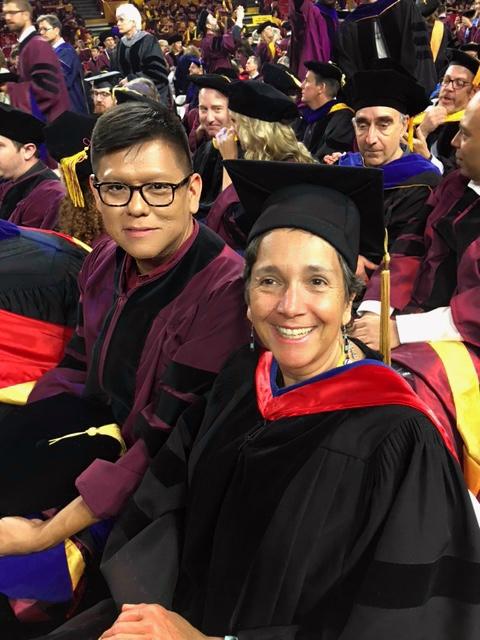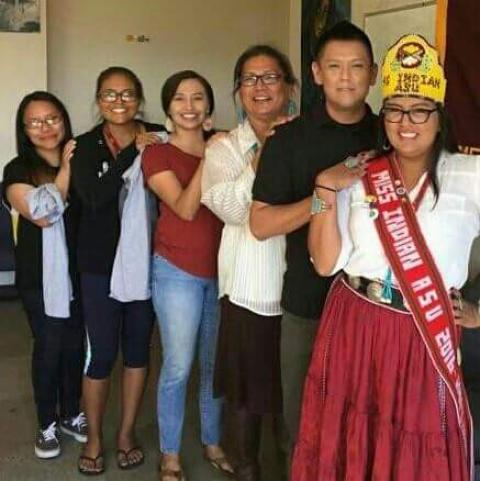 |
Canku Ota
|
 |
|
(Many Paths)
|
||
|
An Online Newsletter
Celebrating Native America
|
||
|
September 2017 - Volume
15 Number 9
|
||
|
|
||
|
Native Doctor Heading
To Ole Miss, Research Will Focus On Navajo Children
|
||
|
by Tanya H. Lee - Indian
Country Today
|
||
|
First Navajo doctor at University of Mississippi knows a cultural language difference from a speech impairment
Dr. Davis E. Henderson is leaving Pueblo Pintado, New Mexico, to take up his appointment as an assistant professor in the Department of Communication Sciences & Disorders at the University of Mississippi. He will be the first Navajo hired by the department and will join four other American Indians who serve on the faculty at Ole Miss. Dr. Teresa Carithers, interim chair of the Department of Communication Sciences & Disorders, said, "We are very excited to welcome Dr. Henderson to the department. He comes to us as a teacher scholar credentialed and experienced in his clinical discipline, with an exciting original and innovative research agenda which has focused on the Navajo population. He also brings knowledge and passion for the importance of understanding the interrelationship of culture to teaching, research and practice." Henderson's three sisters and parents will be going with him as he fulfills a dream that began two decades ago when he was living in a dorm for American Indian kids attending Aztec High School. By his senior year, Henderson had completed all but one English class, "but they wouldn't allow me to go back to the dorm and just hang out and watch TV all day. They said I either had to go to school from home, which was two hours away, so that wasn't an option, or add more courses and stay at school all day." He volunteered for peer tutoring and was assigned to a special needs student. "I worked with him individually and noticed that he would sometimes leave the classroom with another teacher. I found out he was seeing a speech and language pathologist. I watched her work with him and I really fell in love with what she was doing and I thought to myself, that is what I want to do." Two years at Diné College in Crownpoint, New Mexico earned Henderson an associate's degree in elementary education and liberal arts, then he transferred to the University of New Mexico to earn a bachelor's in speech and hearing sciences. "It was a very big transition," he recalled. "At Diné College we had only 10 or 15 people in a class. My first biology course at UNM was in a huge auditorium with approximately 250 students. It was something very unexpected, but I adjusted quite well." He said going to class each day and being aware that this environment was going to be his everyday reality helped.
After UMN, Henderson took a year off. "To be a speech language pathologist you had to have your master's. I wasn't really keen on going to get my master's. I decided to work in a non-profit organization with special needs children in Gallup, New Mexico. A lot of people were saying maybe you should at least try to get your master's. But I knew how competitive the field was; I didn't know if my GRE scores would be high enough to compete." He finally applied to Central Michigan University and tried not to have any expectations about the outcome. When the letter finally came, he left it on the table unopened for a week. "I went there for two years," he said, "and that was another huge transition, going from New Mexico to Michigan. It started snowing in October, and I asked my classmate, 'Why is it snowing? it's only October.'" She said it was normal. Both the early snow and the summer humidity were tough and though he enjoyed the school, he packed up his car and drove straight home as soon as he graduated in 2007. He got a job with the Gallup-McKinley County Schools and there began the work that would shape his research and career for the next several years. Working as a speech and language pathologist, Henderson found that it was almost impossible to "graduate" Navajo children from the program. "It was very difficult to exit Navajo children out of speech therapy. We would see they were making gains, but then we had to use a standardized assessment and those assessments were not appropriate," so the kids did not pass, he explained. The required tests, Henderson said, "did not take into account the linguistic characteristics of Navajo children. Often their first language is English, but we carry over Navajo speech sounds into our English speech sounds. So when we speak, our Navajo language becomes apparent and often speech and language pathologists who are not aware of these characteristics will identify Navajo children as having a speech impairment or speech impediment when they do not. "For example, in the Navajo language we do not have the r sound. But in English we do have the r sound. So a Navajo child who spends a lot of time with their grandparents who do not produce the r sound will probably not produce that sound in English. When we gave the assessment we would say this child still has a speech impairment when it's not an impairment—it's a cultural language difference." In May, Henderson graduated from Arizona State University with a Ph.D. For his dissertation, he investigated using a dynamic assessment—which involves a pre-test, a teaching intervention and a post-test—to evaluate Navajo preschoolers' language status. "We found that the dynamic assessment does indeed differentiate between Navajo children with language impairment and Navajo children with typical developing language. This is a better way to identify Navajo children who need services rather than using the traditional standardized assessments."
Henderson will be teaching at Ole Miss and pursuing his research into creating speech and language assessments for Navajo children that accurately reflect their abilities. "What I would like to do is to look at the speech sounds Navajo people produce—how do they produce the English sounds, what Navajo influences carry over into their English that should not be counted as errors but as cultural speech differences?" His work would have implications for speech and language assessments for children from other tribes as well. He also wants to look at how speech and language pathologists can implement and incorporate cultural values into their interventions for a Native population. But the first challenge, Henderson said, is to figure out what to pack! The University of Mississippi's Department of Communication Sciences & Disorders offers a fully accredited graduate program that develops entry level speech language pathology professionals, students transitioning into audiology and graduate research venues. The department admits 30-35 graduate students per year and now has over 400 undergraduates enrolled for the upcoming academic year, according to Carithers. |
||||||
|
|
|
|
||
|
|
||
| Canku Ota is a free Newsletter celebrating Native America, its traditions and accomplishments . We do not provide subscriber or visitor names to anyone. Some articles presented in Canku Ota may contain copyright material. We have received appropriate permissions for republishing any articles. Material appearing here is distributed without profit or monetary gain to those who have expressed an interest. This is in accordance with Title 17 U.S.C. Section 107. | ||
|
Canku Ota is a copyright ©
2000 - 2017 of Vicki Williams Barry and Paul Barry.
|
||
 |
 |
|
|
The "Canku
Ota - A Newsletter Celebrating Native America" web site and
its design is the
|
||
|
Copyright ©
1999 - 2017 of Paul C. Barry.
|
||
|
All Rights Reserved.
|
||


